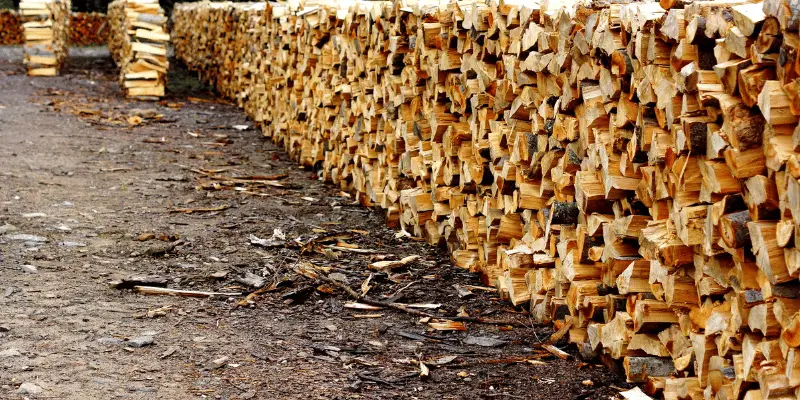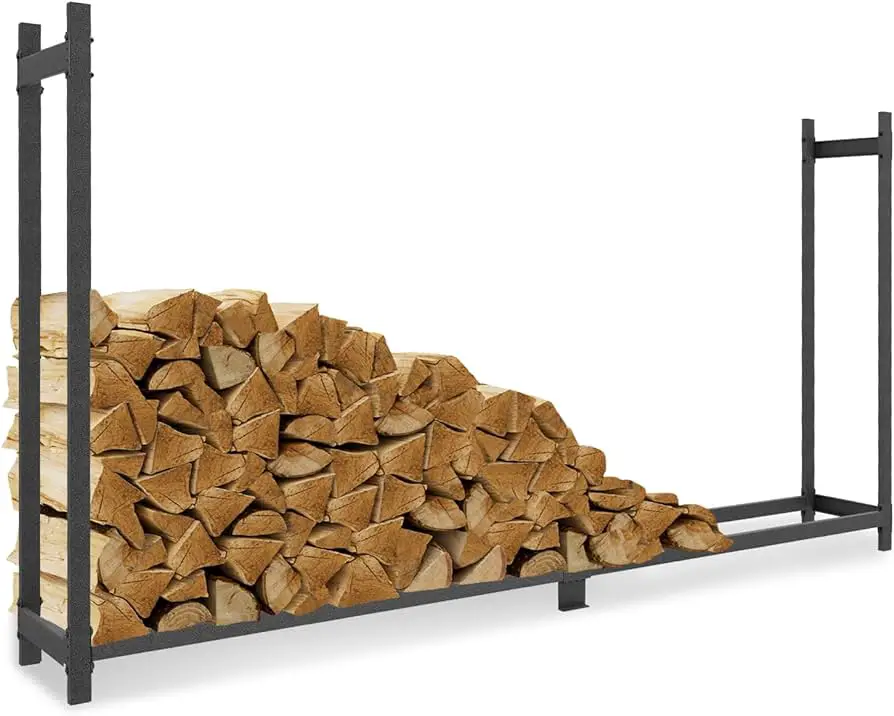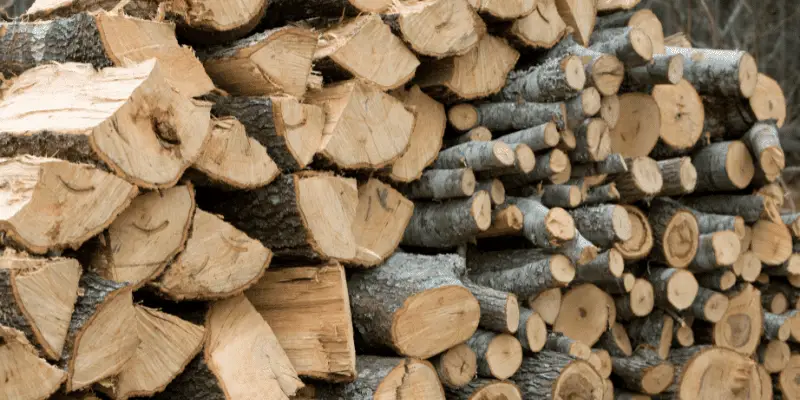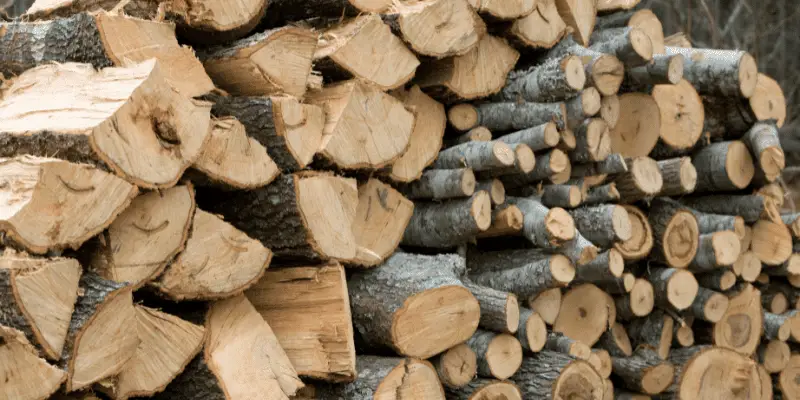A cord of wood is a measurement used to quantify a specific volume of firewood. It refers to a stacked pile that measures 4 feet in height, 8 feet in width, and 4 feet in depth, totaling 128 cubic feet.
This measure has been standardized in the United States and is commonly used to determine the amount of firewood needed for heating purposes or other applications. It helps individuals and businesses accurately estimate the quantity of wood required, ensuring they have an adequate supply for their needs.
Understanding the measurement of a cord of wood is crucial for those involved in the buying, selling, or usage of firewood.
Understanding Firewood Measurements
A cord of wood is a standard measurement used to determine the amount of firewood in a stack. It typically equates to a pile measuring 4 feet high, 4 feet wide, and 8 feet long. When ordering firewood, understanding the measurement can help ensure you get the right quantity for your needs.
Firewood is an essential fuel source for heating and cooking, especially during the winter months. When purchasing firewood, it’s important to understand the measurements used to ensure you get the right amount for your needs. In this section, we will explore the need for standardized firewood units and delve into the history and origins of the cord of wood.
The Need For Standardized Firewood Units:
- Standardized units help ensure consistency in firewood purchases and usage.
- A lack of standardized units can lead to confusion and discrepancies in measurements.
- By establishing a common measurement, consumers can accurately compare prices and quantities across different suppliers.
- Standardized units also help regulate the firewood industry and protect consumers from scams or deceptive practices.
History And Origins Of Cord Of Wood:
- The term “cord” has been used to measure firewood for centuries and originated in the United States.
- The word “cord” is derived from the Old English word “corde,” meaning a string or a long, thin piece of wood.
- The cord of wood was initially defined as a stack measuring 8 feet long, 4 feet high, and 4 feet wide.
- Over time, variations of the cord measurement emerged, such as the face cord and the rick, causing confusion in the marketplace.
- To address this confusion, the National Conference on Weights and Measures (NCWM) established a standard definition for the cord of wood in the late 19th century.
- According to the NCWM, a cord of wood is a neatly stacked volume of wood measuring 128 cubic feet, regardless of the shape or dimensions of the stack.
Understanding firewood measurements is crucial when purchasing wood for your heating needs. By familiarizing yourself with standardized units such as the cord of wood, you can ensure you get the right quantity and value for your money.

Defining A Cord Of Wood
A cord of wood is a unit of measurement used to define a quantity of firewood. It typically consists of a neatly stacked pile measuring 4 feet high, 4 feet wide, and 8 feet long, equaling 128 cubic feet of wood.
The Definition Of A Cord Of Wood:
- A cord of wood is a standard unit of measurement used to quantify the amount of firewood. It represents a specific volume of wood that is neatly stacked and tightly packed.
- The exact definition of a cord of wood may vary slightly depending on the region, but generally, it refers to a stack of wood that measures 4 feet high, 4 feet wide, and 8 feet long.
- To put it simply, a cord of wood is equivalent to a stack that is 128 cubic feet in volume.
How The Cord Of Wood Is Measured:
- When measuring a cord of wood, it is important to consider the stacking method. The wood should be stacked with uniformity and tightness to ensure an accurate measurement.
- The measurement is typically based on the outer dimensions of the stack. This means that if the wood extends beyond the 4x4x8 dimensions, it is not considered part of the cord.
- In some cases, the measurement may be adjusted to account for the air space between the logs. The allowance for this space could vary, so it’s crucial to understand the specific guidelines in your area.
The Legal Requirements For A Cord Of Wood:
- The regulations regarding the sale and purchase of firewood by the cord can differ from one jurisdiction to another. It’s important to familiarize yourself with the legal requirements in your area.
- Some areas have specific labeling requirements for firewood sold by the cord, such as including the term “cord” and the volume measurement on the label.
- It is also common for regulations to specify penalties for misrepresenting the amount of firewood being sold. This ensures fair transactions and protects consumers from being deceived.
A cord of wood is a standardized unit of measurement used to quantify the amount of firewood. It refers to a stack of wood that measures 4 feet high, 4 feet wide, and 8 feet long, or 128 cubic feet in volume.
When measuring a cord of wood, the stacking method and the allowance for air space should be taken into account. Additionally, it is important to understand the legal requirements and regulations concerning the sale and purchase of firewood by the cord in your jurisdiction.
Different Types Of Firewood Measurements
A cord of wood is a standard measurement that refers to a stack of firewood measuring 4 feet high, 4 feet wide, and 8 feet long. It is important to understand this measurement when purchasing firewood for heating or other purposes.
Firewood is an essential resource for keeping warm and cozy during the colder months. But have you ever wondered how firewood is actually measured? In this section, we will explore different types of firewood measurements commonly used in the industry.
From face cords to rick cords, regional variations, and fractional cord measurements, we will cover it all.
Common Firewood Measurements
Firewood measurements can vary depending on the area and the seller. Here are some of the most common firewood measurements you may come across:
- Face Cord Measurement: A face cord is a stack of firewood that measures 8 feet in length and 4 feet in height. The depth of the stack can vary, typically ranging from 12 to 16 inches. It is important to note that a face cord is not considered a full cord of wood.
- Rick or Rick Cord Measurement: A rick, also known as a rick cord, is another popular measurement for firewood. A rick usually measures 4 feet in height, 8 feet in length, and has a variable depth. Similar to a face cord, a rick is not equal to a full cord of wood.
Regional Variations In Firewood Measurements
Depending on where you live, you may come across different measurements for firewood. Here are some regional variations:
- Full Cord Variations: In some areas, a full cord of wood is defined as a stack that measures 4 feet in height, 4 feet in width, and 8 feet in length. However, in other regions, a full cord may be defined differently. It’s essential to familiarize yourself with the specific measurements used in your area to ensure you are getting the right amount of firewood.
Fractional Cord Variations
In addition to the common measurements mentioned above, fractional cord variations are also used:
- Half Cord Measurement: As the name suggests, a half cord is half the size of a full cord. It measures 4 feet in height, 4 feet in width, and 4 feet in length.
- Quarter Cord Measurement: A quarter cord is even smaller, measuring 2 feet in height, 4 feet in width, and 4 feet in length.
- Eighth Cord Measurement: An eighth cord is the smallest measurement and is typically used for smaller or occasional firewood needs. It measures 2 feet in height, 2 feet in width, and 4 feet in length.
Understanding the different types of firewood measurements can be helpful when purchasing firewood. It ensures you get the right amount of wood for your needs, whether you’re heating your home or enjoying a cozy campfire. Keep in mind that these measurements may vary depending on your location, so it’s always best to clarify with the seller before making a purchase.
Happy wood burning!

How Much Wood Is In A Cord?
A cord of wood is a measurement that equates to a stack measuring 4 feet high, 4 feet wide, and 8 feet long. It consists of approximately 128 cubic feet of wood.
Calculating The Amount Of Wood In A Cord
When it comes to buying firewood, understanding the quantity of wood you’ll receive is essential. One common measurement used for firewood is a cord. But just how much wood does a cord actually contain? Let’s break it down:
- A cord of wood is a unit of measurement used to quantify firewood. It is defined as a stack of wood that measures 4 feet high, 4 feet wide, and 8 feet long. This totals 128 cubic feet of firewood.
- Imagine stacking logs neatly in rows, making sure they are tightly packed. This will help you calculate the amount of wood in a cord accurately.
- Keep in mind that the measurement of a cord applies to a tightly stacked pile. If the wood is loosely stacked or irregularly shaped, you may end up with less usable firewood.
Factors Affecting The Amount Of Wood In A Cord
Several factors can influence the actual amount of wood you get when purchasing a cord. These include:
- Log Length: The length of the logs can vary depending on the supplier. Longer logs will take up more space, resulting in fewer logs within a cord. On the other hand, shorter logs will allow for more pieces to fit in the same volume.
- Wood Species: Not all woods have the same density, meaning there can be variations in weight and volume. Hardwood species like oak or hickory generally provide more heat and have a higher density compared to softwoods like pine or spruce.
- Moisture Content: Wood that contains moisture or hasn’t been properly seasoned will weigh more and produce less heat. It’s crucial to ensure the firewood is properly seasoned to maximize its energy efficiency.
Standard Dimensions Of A Cord
To get a better idea of the volume of wood in a cord, let’s break down the standard dimensions involved:
- Height: A cord is typically stacked 4 feet high. This vertical measurement helps ensure the stacked logs remain stable and secure.
- Width: A cord should be stacked 4 feet wide. This width allows for easy access to the wood while maintaining stability.
- Length: A cord measures 8 feet in length. This length provides ample space for stacking various log sizes efficiently.
Understanding The Stackability Of Wood
When stacking firewood to form a cord, it’s important to consider the stackability of the wood. Here are a few insights to keep in mind:
- Log Orientation: To optimize space, logs are typically stacked parallel to the length of the cord. This ensures a neat and compact arrangement.
- Consistency: Maintaining a consistent width and height throughout the stack allows for a more accurate measurement of a cord.
- Air Gaps: While stacking, it’s crucial to minimize air gaps between logs. Tight stacking increases the amount of wood within a cord and maximizes the usable space.
Remember, a cord of wood provides a reliable measure for estimating the quantity of firewood you’ll receive. Keep in mind the various factors that can affect the amount of wood in a cord, and always ensure the wood is properly seasoned for optimal heat output.

The Importance Of Accurate Firewood Measurements
Accurate firewood measurements, such as knowing what a cord of wood is, are crucial for homeowners and businesses alike. Understanding the quantity of wood purchased ensures fair pricing and adequate supply for heating or cooking needs.
When it comes to purchasing firewood, understanding accurate measurements is crucial. The amount of firewood you receive can greatly impact your satisfaction and the efficiency of your wood-burning endeavors. In this section, we will explore the importance of accurate firewood measurements and how they can ensure fair transactions, help you avoid overpaying or underpaying, and allow for efficient use of firewood.
Ensuring Fair Transactions
- Knowing the proper measurements of firewood ensures that you get what you pay for.
- Accuracy in measuring firewood guarantees fairness and transparency in transactions.
- Both the buyer and seller can trust that they are getting the agreed-upon amount of firewood.
Avoiding Overpaying Or Underpaying
- Accurate firewood measurements prevent overpaying for less wood or underpaying for more wood.
- By knowing the standard measurements, you can easily identify if you are being charged unfairly.
- Overpaying or underpaying for firewood can significantly impact your budget and overall satisfaction.
Efficient Use Of Firewood
- Having accurate measurements allows you to plan and use firewood efficiently.
- You can estimate the amount of firewood needed for a specific period accurately.
- Efficient use of firewood helps you avoid running out during the colder months or having excess wood that goes unused.
Accurate firewood measurements ensure fair transactions, prevent overpaying or underpaying, and enable efficient use of firewood. By understanding the importance of accurate measurements, you can engage in transactions with confidence, manage your budget effectively, and maximize the use of your firewood.
Tips For Buying Firewood
A cord of wood is a commonly used measurement for firewood. Knowing what a cord of wood is can help you accurately purchase the right amount for your needs.
When it comes to buying firewood, there are a few key factors to consider. Whether you’re purchasing firewood for your fireplace or wood-burning stove, it’s important to find reliable suppliers, recognize quality firewood, and understand pricing and measurement terms. By following these tips, you can ensure you’re getting the best firewood for your needs.
Finding Reliable Firewood Suppliers:
- Ask for recommendations: Reach out to family, friends, or neighbors who have purchased firewood before. They can provide valuable insights and suggest reliable suppliers.
- Check online reviews: Look for firewood suppliers in your area and read reviews from previous customers. This can give you an idea of their reputation and reliability.
- Contact local tree services: Tree removal companies often sell firewood as a byproduct of their operations. Reach out to them and inquire about purchasing firewood directly.
- Visit local farms: Some farmers sell firewood as well. Check if there are any farms in your area that offer firewood for sale.
Recognizing Quality Firewood:
- Look for seasoned wood: Seasoned firewood is wood that has been cut and dried for at least six months. It has a lower moisture content, making it easier to burn and providing more heat. Look for dry, grayish wood with cracks on the ends.
- Check for insects: Inspect the firewood for signs of insects or pests. Avoid purchasing firewood that shows any infestation, as it can lead to problems in your home.
- Consider the type of wood: Different types of wood have different burning characteristics. Hardwoods like oak and maple tend to burn longer and produce more heat, while softwoods like pine and spruce burn faster but may not provide as much heat. Choose the wood that suits your specific needs.
Understanding Pricing And Measurement Terms:
- Cord: A cord is a standard unit of measurement for firewood. It refers to a stack of wood that measures 4 feet high, 4 feet wide, and 8 feet long. A cord typically contains about 128 cubic feet of firewood.
- Face cord: A face cord is another unit of measurement for firewood. It is typically 4 feet high and 8 feet long but can be any width. The volume of a face cord can vary depending on the width of the wood.
- Half cord or quarter cord: Some suppliers offer firewood in smaller quantities, such as half cord or quarter cord. These measurements are fractions of a full cord and can be useful if you have limited storage space.
- Price per cord: Firewood prices are often quoted per cord. However, it’s important to clarify the specific measurements being used to avoid any confusion or overpayment.
By following these tips, you’ll be well-equipped to find reliable firewood suppliers, recognize quality firewood, and navigate pricing and measurement terms. Remember to choose seasoned wood, consider the type of wood, and ask relevant questions to ensure you get the best firewood for your needs.
Stay warm and cozy throughout the winter months!
Seasoning And Storing Firewood
A cord of wood is a standard unit of measurement for firewood, equaling 128 cubic feet. It is important to properly season and store firewood to ensure its quality and longevity.
Firewood is an essential fuel source for many households, providing warmth and comfort during colder seasons. However, it is crucial to properly season and store firewood to ensure a safe and efficient burning experience. In this section, we will explore the importance of properly seasoned firewood, methods for seasoning firewood, and best practices for storing firewood.
Importance Of Properly Seasoned Firewood
Properly seasoned firewood is the key to a successful and enjoyable fire. Here are some reasons why it is important:
- Efficient burning: Seasoned firewood burns more efficiently, producing more heat and less smoke. It ignites easily, resulting in a hotter fire and reducing the risk of chimney creosote buildup.
- Reduced moisture content: Seasoned firewood has a low moisture content, typically around 20%. This allows the wood to burn cleanly without excessive steam or smoke, maximizing heat output.
- Longer burning time: With lower moisture content, seasoned firewood burns longer, providing a sustained source of warmth for a more extended period.
Methods For Seasoning Firewood
Properly seasoning firewood involves removing moisture from the wood to enhance its burning qualities. Here are some common methods:
- Air drying: This traditional and cost-effective method involves stacking firewood in a location with good air circulation and allowing it to naturally dry over time. It typically takes at least six months to a year for firewood to properly season using this method.
- Sheltered storage: Storing firewood under a covered structure, such as a shed or canopy, helps protect it from excessive rain and snow while allowing air to circulate. This method can speed up the seasoning process compared to outdoor storage.
- Splitting the wood: Splitting firewood exposes more surface area to air and helps accelerate the drying process. Smaller pieces dry faster than larger logs, so splitting the wood into manageable sizes can help speed up the seasoning.
Best Practices For Storing Firewood
Proper storage of firewood is essential to maintain its quality for efficient burning. Here are some best practices to consider:
- Elevated storage: Storing firewood off the ground on pallets or raised racks helps prevent moisture absorption from the soil and reduces the risk of insect infestation.
- Good airflow: When stacking firewood, leave space between the logs to allow air circulation. This helps prevent mold and mildew growth and ensures consistent seasoning throughout the woodpile.
- Dry and sunny location: Choose a storage location that receives ample sunlight to aid in the drying process. Avoid areas with excessive moisture or shade, as this can hinder proper seasoning.
- Rotate the woodpile: If possible, rotate the firewood pile, using older wood first and restacking newer additions to ensure even seasoning and prevent wood decay.
By following these guidelines for seasoning and storing firewood, you can maximize the efficiency and enjoyment of your fires while promoting a safe and healthy burning environment. Remember, properly seasoned firewood is the key to a warm and cozy atmosphere during those cold winter evenings.
Safety Precautions When Handling Firewood
A cord of wood is a measure used to quantify firewood, typically a stack measuring 4 feet high, 4 feet wide, and 8 feet long. It is essential to follow safety precautions when handling firewood to prevent accidents and ensure a safe environment.
When it comes to handling firewood, it’s essential to prioritize safety. The last thing you want is an accident or injury while enjoying a cozy fire. By following these safety precautions, you can ensure a smooth and worry-free experience:
Safe Handling Techniques:
- Wear appropriate protective gear, such as gloves and safety goggles, to avoid splinters or debris.
- Lift firewood with your legs instead of your back to prevent strains and muscle injuries.
- Use caution when moving heavy logs and avoid overexertion to minimize the risk of sprains or pulled muscles.
Avoiding Hazards And Injuries:
- Keep your work area well-lit and free of obstacles to reduce the likelihood of falls or tripping accidents.
- Avoid stacking firewood near doorways or walkways to prevent potential hazards for yourself and others.
- Be mindful of sharp tools, such as axes or chainsaws, and ensure proper handling and storage to avoid accidental injuries.
Protecting Against Insects And Pests:
- Inspect firewood before bringing it indoors to prevent introducing insects or pests into your home.
- Store firewood away from your house and on elevated surfaces to discourage infestations.
- Cover firewood with a tarp or plastic sheet to protect it from rain and prevent moisture build-up, which attracts pests.
Remember, safety should always be the top priority when handling firewood. By following these precautions, you can enjoy your fireside moments without any unnecessary risks or interruptions.

Frequently Asked Questions Of What Is A Cord Of Wood
How Much Wood Is 1 Cord?
One cord of wood measures approximately 128 cubic feet.
Can You Fit A Cord Of Wood In A Pickup Truck?
Yes, a pickup truck can fit a cord of wood.
Is A Cord Of Wood 4X4X4?
No, a cord of wood measures 4 feet high, 4 feet wide, and 8 feet long.
Why Do They Call It A Cord Of Firewood?
A cord of firewood is called so because it refers to a specific quantity of wood, typically measuring 4 feet high, 4 feet wide, and 8 feet long.
Conclusion
Understanding what a cord of wood is can greatly benefit homeowners and anyone who relies on wood for heating or other purposes. It is a standard unit of measurement that helps determine the quantity of wood needed for specific needs.
Whether you’re purchasing firewood, estimating the amount of wood needed for a woodworking project, or comparing the cost of different wood suppliers, knowing what a cord of wood is and how it is measured is essential. By definition, a cord of wood is a neatly stacked pile of wood that measures 4 feet high, 4 feet wide, and 8 feet long, totaling 128 cubic feet.
However, it’s important to note that there are variations, such as the face cord or the stove cord, which have different dimensions. By understanding the measurements and the various terms used in the wood industry, you can make informed decisions and ensure you have enough wood to meet your needs.
So, next time you hear someone mention a cord of wood, you’ll know exactly what they’re talking about. With this knowledge, you can confidently navigate the world of firewood and woodworking with ease.



3 thoughts on “What is a Cord of Wood? Discover the Power of Firewood Measurements”